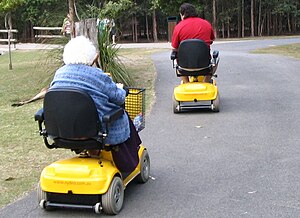Motorized shopping cart
From Wikipedia, the free encyclopedia
A motorized shopping cart (also known as electric shopping cart) is a shopping cart equipped with an electric motor and navigational controls. It includes a seat (often times equipped with an occupant seat switch activating movement of the motorized shopping cart from the occupant's weight) thereby also making it a motorized wheelchair, and it has a rechargeable battery that can be charged by plugging in the device when not in use in order to maximize usage. Motorized shopping carts are provided by supermarkets and other large retail stores for those with permanent or temporary physical disabilities who may have difficulty walking through a large store or pushing a regular cart[1][2][3].The first motorized shopping carts were manufactured by Amigo Mobility International Inc, in Bridgeport, Mich. Fred Meijer was the first retailer to introduce motorized shopping carts in his Flint, Mich. Meijer location in 1970. Since then, multiple manufacturers have developed these products for those with walking difficulties worldwide.
Sage Industries in Arkansas introduced their product in Klein's Supermarket in Tomball, Texas in 1985[4][5]. They have since expanded to numerous other stores around the world and benefited many with various disabilities and even pregnant women.
Many of the customers who use motorized shopping carts are not full-time wheelchair users, but find shopping easier using the device since a regular cart may be harder to push, especially when filled with merchandise, and walking through a large store may be cumbersome for one who is able to walk only short distances on their own power.
Contents[hide] |
[edit] Issues
[edit] Theft
While shopping cart theft has also been a costly matter for retailers, the higher cost of the motorized carts makes their theft a greater issue to the store, and thereby leads stores to establish policies prohibiting the carts from exiting stores, even though a disabled person may have the need to bring the cart all the way to their vehicle.In May 2009, a Florida man was charged with felony theft of a motorized cart due to its $2500 value. He was caught not far from the store, riding the cart[6]. Had a non-electric cart been stolen, the theft would have been a misdemeanor.
In the same month, two South Carolina men were charged with the theft of a cart, and likewise faced felony charges due to it value over $2000[7].
[edit] Injuries
There has been concern over the carts leading to injuries when used by those who do not know how to control them well. The injuries can occur to the user if s/he crashes into an object with the cart, or to a person the user crashes into. To reduce the risk of injury, most carts have a back-up warning system similar to those found on trucks.In Illinois in 2008, a $50,000 lawsuit was filed by a woman who was hit by a cart steered by an employee of a supermarket[8]. The woman claimed she sustained hip injuries as a result[9][10].
[edit] Permission to use
While these carts are generally reserved for the disabled, most stores will take one's word for being a disabled person and will not challenge one's need for a cart. But there have been some cases reported in which a person with a non-visible disability has requested the use of a motorized cart, but has been denied the use by store employees who do not believe the customer has a disability.There has also been concern over minors using the carts. In January 2009, a Wal-Mart store in Tennessee did not allow an 11-year-old girl with a broken leg to use a motorized cart, despite the fact that she had been allowed by other stores to use them.
Also of concern is who should have priority in using the cart. In August 2009, a 28-year-old man was charged with battery when he pushed an 86-year-old man out of a motorized cart when the 86-year-old man allegedly took a motorized cart that the 28-year-old's mother was using.[11].
[edit] In popular culture
- In the Kevin James comedy Paul Blart: Mall Cop, a man is pulled over for speeding on an motorized shopping cart[12].
[edit] See also
[edit] External links
[edit] References
- ^ Mart Carts help benefit disabled persons, The Victoria Advocate - Aug 8, 1993
- ^ Electric shopping carts serve growing number of consumers.
- ^ Electric shopping carts add convenience, Rome News-Tribune - Apr 15, 2002
- ^ Shopping made easy for handicapped, Gainesville Sun - Jun 19, 1985
- ^ There are special carts for handicapped shoppers, The Evening Independent - Jun 19, 1985
- ^ Late-Night Joyride On Motorized Shopping Cart Lands Man In Jail, May 01, 2009
- ^ 2 Arrested In Shopping Cart Theft, May 12, 2009
- ^ http://www.pioneerlocal.com/lakeforest/news/1778897,lawsuit-sunset-foods-091809-s1.article[dead link]
- ^ Woman Hit By Shopping Cart Sues Jewel
- ^ Herniated nucleus pulposis injury claimed in Wal-Mart shopping cart incident, 9/15/2009
- ^ Suspect pushes man, 86, out of Wal-Mart cart, August 7, 2009
- ^ By Michael JanusonisJournal Arts Writer (2009-01-16). "Movie Review: ‘Mall Cop’ would have been a decent TV sitcom | projo.com | The Providence Journal | Movie Reviews". projo.com. http://www.projo.com/movie_reviews//lb_paulblart_01-16-09_5MCUQPN_v6.2de1c51.html. Retrieved 2010-07-29.

